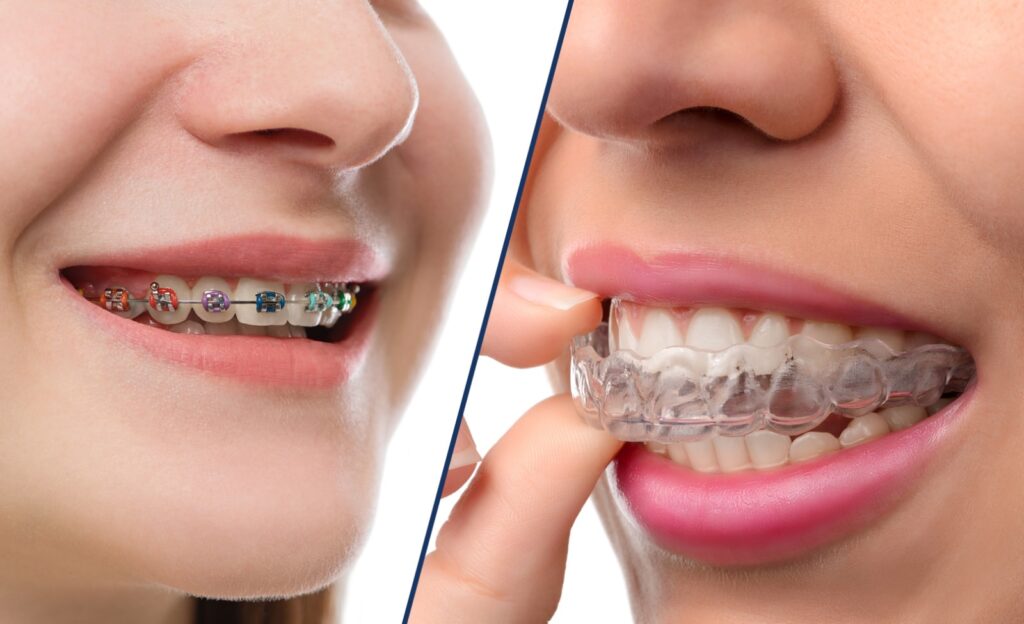How do braces work? Function, comparison with invisible aligners and more

braces vs aligners
In orthodontic treatment, braces are often used to correct misalignment issues such as overcrowding and gaps in teeth. While braces have been around for decades, technology has evolved to become more efficient and less noticeable. In this comprehensive overview, we’ll discuss how braces work, compare them to invisible aligners, and provide an overview of their benefits.
What are braces?
Braces are appliances used to correct misaligned teeth. They work by placing pressure on the tooth to slowly and gradually move it into the desired position. Teeth braces have been around for many years now, and they come in a variety of shapes and sizes depending on your individual needs. Traditional braces involve metal braces and wires with elastic bands, while modern braces involve clear braces and invisible aligners. Each type has its unique benefits, so it is important to consult a dentist or orthodontist when considering braces to determine which option is right for you.
How do braces work?
Braces are a type of orthodontic appliance used to help realign and straighten teeth to improve one’s smile and correct bite problems. They work by using a system of brackets, wires and rubber bands which cause gentle pressure on the teeth while braces are in place. This pressure helps shift the teeth into better alignment. Modern braces come in various materials including metal, ceramic and plastic as well as invisible aligners that may be used according to individual needs. makeO toothsi, for instance, uses clear aligners that are nearly undetectable when worn over the teeth, making them a popular choice for adults looking for more discreet orthodontic treatment. Over time braces help reposition the teeth into their optimal position creating a beautiful smile that will last a lifetime!
Dental problems you can treat with braces
Did you know braces aren’t just for minor aesthetic improvements? Not only can braces help you straighten your teeth, but they can also be an effective tool against serious dental issues. With braces, you can correct misaligned bite or teeth overcrowding problems to reduce the risk of cavities and gum diseases. Clear aligners are also extremely helpful when treating alignment issues. Not only do they provide the same level of orthodontic benefits as braces, but they also offer a discreet way to maintain oral hygiene and have a beautiful smile!
Braces vs Aligners
Invisible aligners or clear aligners provide an alternative option for straightening teeth without traditional metal braces. Unlike braces, invisible aligners are made from clear plastic moulds that fit snugly over your teeth without any metal wires or brackets involved. They also don’t require frequent adjustments like traditional braces do—instead, they should be swapped out every two weeks for a new set of aligners as they gradually move your teeth into place over time. However, while invisible aligners offer a more discreet option than traditional braces do, they may not be suitable for all types of orthodontic problems since they can’t exert as much force on your teeth as traditional braces can. Before deciding which option is right for you, it’s best to consult with an orthodontist who can help you determine which type of treatment will best address your needs.
Braces offer a reliable way to correct misaligned smiles while providing additional benefits such as improved gum health and better access for brushing and flossing between overlapping teeth. Whether you choose traditional metal braces or opt for invisible aligners instead depends on factors such as the severity of misalignment issues present in your mouth and personal preference when it comes to aesthetics. Ultimately, consulting with an orthodontist is the best way to determine which type of treatment is right for you based on both practical considerations like cost and time investment involved as well as aesthetic concerns related to how visible or discreet you would like your treatment options to be throughout the process.





